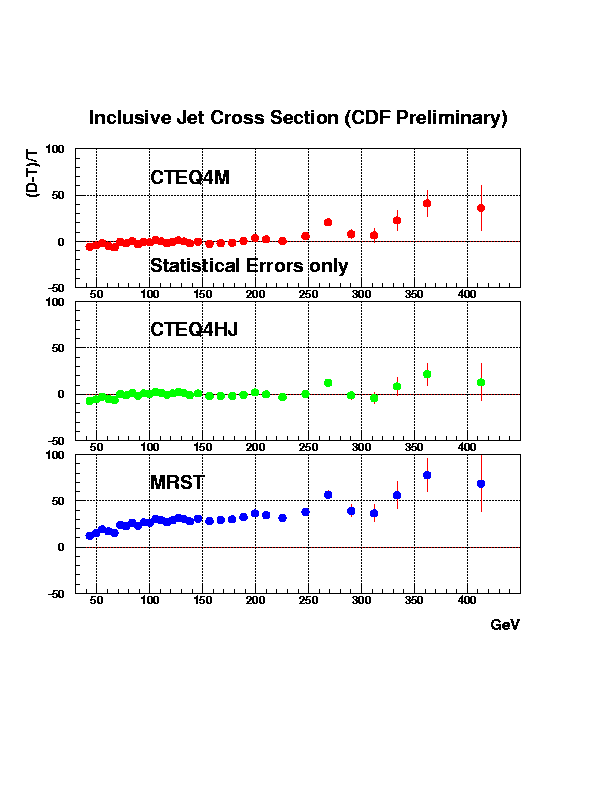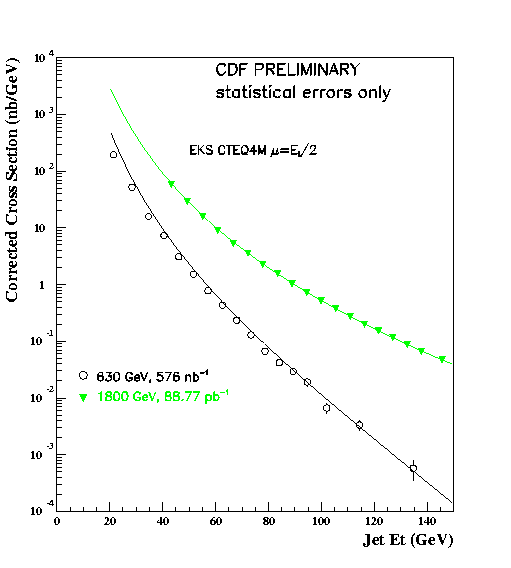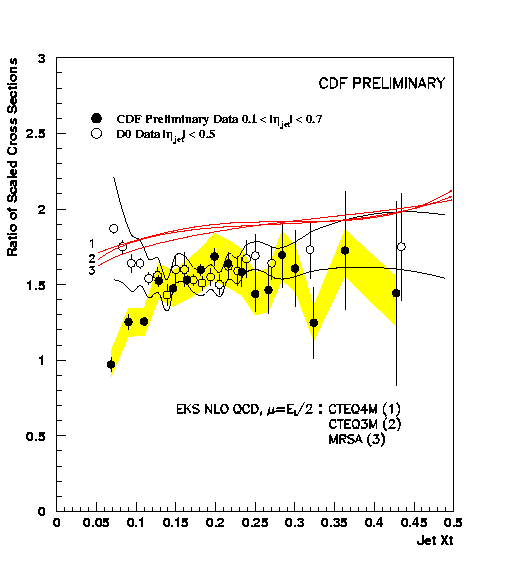Understanding jet cross sections and x_T scaling
J.F. Owens, Florida State University
Large momentum transfer processes have long been used to study the
substructure of the target particles, dating back to Rutherford's
discovery of the atomic nucleus. In that experiment, a higher than expected
rate for wide angle scattering of alpha particles from a gold target
indicated the existence of the pointlike nucleus. Similarly, the production
of jets at large values of p_T can serve as a probe of the substructure
of the colliding hadrons. In particular, an excess of events above the
number expected from conventional QCD scattering processes could serve as a
signal for parton subtructure or compositeness.
 Data from both the CDF (Abe et al., 1996)and D0 (Abbott et al., 1999)
Collaborations are consistent with a production rate at high-p_T which
exceeds the QCD-based expectations. Although this would appear to be the
hallmark signal of compositeness, the angular distributions of the
jets in the parton-parton center of mass frame show no deviations from
QCD expectations. If the excess were due to compositeness, then one would
expect a flattening of the jet angular distribution.
Data from both the CDF (Abe et al., 1996)and D0 (Abbott et al., 1999)
Collaborations are consistent with a production rate at high-p_T which
exceeds the QCD-based expectations. Although this would appear to be the
hallmark signal of compositeness, the angular distributions of the
jets in the parton-parton center of mass frame show no deviations from
QCD expectations. If the excess were due to compositeness, then one would
expect a flattening of the jet angular distribution.
Before one can make a case for new physics, it is important to examine
whether or not there might be an explanation based on conventional physics.
Threshold resummation is a technique which can be used to sum large
logarithmic terms which occur near the scattering threshold in the
parton-parton system. In large momentum transfer scattering processes the
resulting corrections can become large as one goes towards the edge of
phase space. However, in this case an early estimate of the threshold
resummation corrections (
Catani et al., 1996 ) shows only about a 5% enhancement which is less
than the observed excess. This has recently been confirmed and extended
(Kidonakis and Owens, 2000) in a calculation
which shows that the threshold
resummation terms reduce the scale dependence, but can not account for all
of the excess.
Another possibility is that the parton distributions at large values of x may
be larger than thought. Deeply inelastic scattering data impose strong
constraints on the quark distributions, but there is more freedom to change
the gluon distribution (
Huston et al., 1998). This possible explanation was first explored in
( Huston et al., 1995).
Subsequently, the CTEQ global fitting group developed special sets of
distributions which were designed to better describe the high-p_T jet data.
The CTEQ4HJ (H.L. Lai et al.,
1996) and CTEQ5HJ (
H.L. Lai et al., 1999) distributions have an enhanced gluon distribution
at high values of x. The CTEQ5HJ distributions seems to
give a better description of recent CDF and D0 Run 1b data than do the regular
CTEQ5M distributions.
It is expected that the higher energy and luminosity which will be available
for Run II at the Tevatron will shed new light on the questions of whether or
not the excess persists to higher values of p_T and, if so, what is it's
underlying source.
Another problem involving the comparison of QCD predictions with jet data
involves the energy dependence of the cross section. In the parton model one
would expect that dimensionless quantity E_T^3 d sigma/dE_T dy would be
constant at fixed x_T and rapidity as the energy
is varied. Here x_T = 2 p_T/sqrt(s). This is referred to as x_T scaling. In
QCD, one has scaling violations due to the running of the coupling and to
the scaling violations in the parton distributions. There is, therefore,
expected to be some energy dependence to the scaled cross section. However,
the energy dependence shown by the data does not match that of the theoretical
predictions. This can be seen in
the two figures below. The interpretation of these results is
that the QCD predictions agree well with
the data at 1800 GeV, but lie above the data at 630 GeV.
This subject has also been discussed in a recent review (Huston, 1999 - see pages 5 and 6).
Several mechanisms have been suggested which might work to explain the
discrepancies noted above. These include splash-in/splash-out and recoil
effects due to initial state gluon radiation. A description of these and
estimates of their effect on the jet cross sections
can be found in ( Soper, 1997), (Pumplin, 1997), and
(Mangano, 1999).
Both the D0 and CDF experiments see similar effects, although there are
some differences in detail at the low end of range covered by the data.
Note that effects due to using different parton distributions tend to cancel
when the data and theory are plotted as ratios, as shown in the above figure.
Thus, inadequacies in the parton distributions can not explain the
differences. Similarly, variations in the theoretical predictions due to
scale changes tend to cancel when a ratio is used.
At a given x_T value, the jets at 630 GeV are a factor of 630/1800 less
energetic than the ones at 1800. The problems observed regarding the
disagreement of the 630 GeV jet cross sections with the theory are
essentially low ET jet problems, where power corrections
of the type discussed above are important. These power corrections fall
off as 1/ET or 1/ET^2.
The study of high energy large momentum transfer phenomena relies on the use
of jet observables and searches for new physics make extensive use of jets.
It is, therefore, vitally important to understand the energy dependence of
jet cross sections.
Comments on this entry may be sent to
J.F. Owens.


 Data from both the CDF (Abe et al., 1996)and D0 (Abbott et al., 1999)
Collaborations are consistent with a production rate at high-p_T which
exceeds the QCD-based expectations. Although this would appear to be the
hallmark signal of compositeness, the angular distributions of the
jets in the parton-parton center of mass frame show no deviations from
QCD expectations. If the excess were due to compositeness, then one would
expect a flattening of the jet angular distribution.
Data from both the CDF (Abe et al., 1996)and D0 (Abbott et al., 1999)
Collaborations are consistent with a production rate at high-p_T which
exceeds the QCD-based expectations. Although this would appear to be the
hallmark signal of compositeness, the angular distributions of the
jets in the parton-parton center of mass frame show no deviations from
QCD expectations. If the excess were due to compositeness, then one would
expect a flattening of the jet angular distribution.

